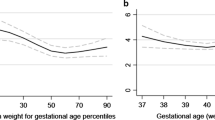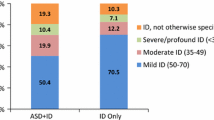Abstract
It is generally accepted that developmental handicaps can often be minimized through early detection and intervention. For this reason, it is normal practice in many hospitals to follow-up and screen infants who present at birth with established risk factors. Clinical judgement will always be important when selecting children for follow-up. However, as hospital data systems improve, automated systems could be developed for listing children potentially “at risk”. Where initial clinical decisions not to follow-up individual children prove to be at odds with this automated output, the individual child could be re-assessed clinically. This process could increase the level of quality control. An initial risk-factor model for intellectual disability has been developed, based on the South Australian Perinatal Statistics Collection, for use in this context.
Similar content being viewed by others
References
Armitage P. (1974): Statistical methods in medical research. — Blackwell Oxford 427–429.
BaroffG.S. (1982): Predicting the prevalence of mental retardation in individual catchment areas. -Ment Retard 3: 133–135.
Clunies-RossG.G. (1986): The development of children with Down's Syndrome: Lessons from the past and implications for the future. - Editorial. Aust. Paediatr. J. 22: 167–169.
EinfeldS.L. (1984): Clinical assessment of 4500 developmentally delayed individuals. - J. Ment. Defic. Res. 28: 129–142.
Epicenter Software (1984): Epilog — Epidemiology and clinical trials statistics package Pasadena: Epicenter Software.
HagbergB., HagbergA., LewerthA. and LindbergU. (1981): Mild mental retardation in Swedish school children. II Etiologic and pathogenetic aspects. - Acta Paediatr. Scand. 70: 445–452.
HagbergB. and KyllermanM. (1983): Epidemiology of mental retardation — A Swedish Survey. - Brain Dev. 5: 441–449.
HartG., MacHarperT., MooreD. and RoderD. (1985): Aboriginal pregnancies and births in South Australia 1981–1982. - Med. J. Aust. 143: S54-S56.
KahnH.A. (1983): An introduction to epidemiologic methods. - Oxford University Press, New York.
MulliganJ.C., PainterM.J., O'DonoghueP.A., MacDonaldH.M., AllenA.C. and TaylorP.M. (1980): Neonatal asphyxia II — Neonatal mortality and longterm sequelae. - J. Pediatr. 5: 903–907.
NelsonK.B. and EllenbergJ.H. (1981): Apgar scores as predictors of chronic neurologic disability. -Pediatrics 68: 36–44.
PetersT.J., GoldingJ., LawrenceC.J., FryerJ.G., ChamberlainG.V.P. and ButlerN.R. (1984): Delayed onset of regular respiration and subsequent development. - Early Hum. Dev. 9: 225–239.
RosenM.G. and HobelC.J. (1986): Prenatal and perinatal factors associated with brain disorders. -Obstet. Gynecol. 68: 416–421.
RyndersJ.E., SpikerD. and HorrobinJ.M. (1978): Understanding the educability of Down's Syndrome children: Examinations of methodological problems in recent literature. - Am. J. Ment. Defic. 82:440–448.
SalonenJ.T. and HeinonenO.P. (1984): Mental retardation and mother's hypertension during pregnancy. - J. Ment. Defic. Res. 28: 53–56.
SimeonssonR.J., CooperD.H. and ScheinerA.P. (1982): A review and analysis of the effectiveness of early intervention programs. - Pediatrics 69: 635–641.
South Australian Health Commission Perinatal Statistics Unit (1982): Guidelines for the supplementary birth record. - Adelaide: South Australian Health Commission, 1982
South Australian Health Commission (1986): Epidemiology Branch. Variation in perinatal risk by place of residence of mother in South Australia. -Adelaide: December 1986.
TaylorD.J., DavidsonJ., HowieP.W., DavidsonD. and DrillienC.M. (1985): Do pregnancy complications contribute to neurodevelopmental disability? -Lancet 8431: 713–716.
TjossemT.D. (1976): Intervention strategies for high risk infants and children. - University Park Press. Baltimore.
UryH.K. (1975): Efficiency of case-control studies with multiple controls per case and continuous or dichotomous data. - Biometrics 31: 643–649.
Author information
Authors and Affiliations
Additional information
Corresponding author.
Rights and permissions
About this article
Cite this article
Jonas, O., Roder, D., Esterman, A. et al. Pregnancy and birth risk factors for intellectual disability in South Australia. Eur J Epidemiol 5, 322–327 (1989). https://doi.org/10.1007/BF00144832
Issue Date:
DOI: https://doi.org/10.1007/BF00144832




